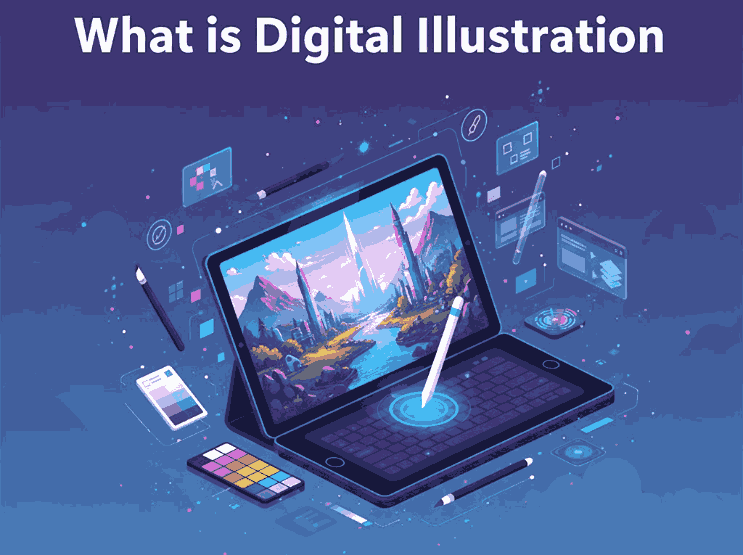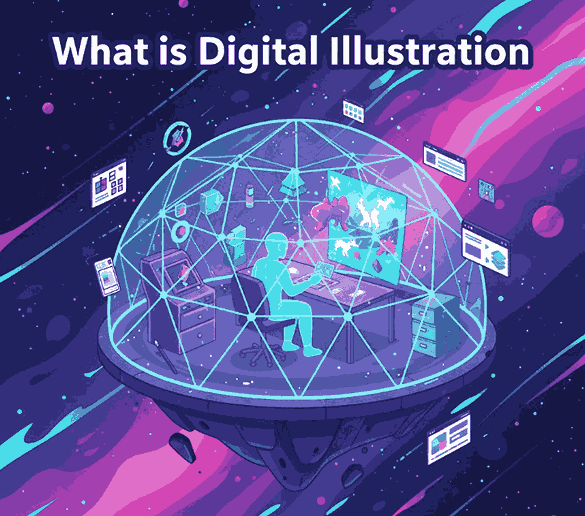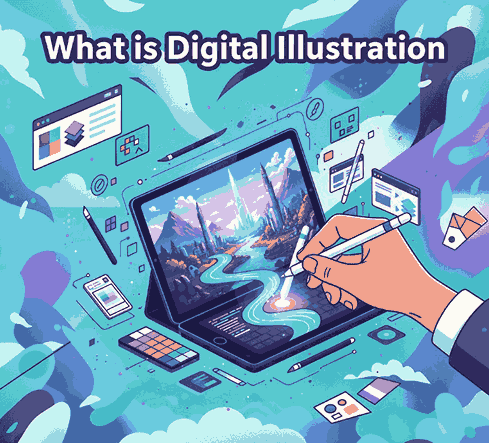
Table of Contents
- Introduction
- Defining Digital Illustration
- How Digital Illustration Differs from Traditional Illustration
- The Tools & Techniques of Digital Illustration
- Practical Applications: Where Digital Illustration Meets Typography & Design
- Examples of Fonts to Use in Digital Illustration Projects
- Conclusion
- References
1. Introduction
What is Digital Illustration In today’s visual driven world, illustration has taken a major leap beyond pen and paper. With the rise of tablets, powerful software and digital workflows, understanding What is Digital Illustration has become key for designers, typographers and creative entrepreneurs alike.
For a business like CalligraphyFonts.net — where you design, create and sell a variety of fonts — digital illustration is especially relevant. Whether you’re developing font displays, mock-ups, branding visuals or mixed media pieces, the intersection of font design and digital illustration offers rich creative potential. In this article, we’ll define digital illustration, explore how it differs from traditional methods, dig into tools and techniques, highlight how it relates to typography and font work, and show how you can apply high-quality fonts from your collection to these kinds of projects.

2. Defining Digital Illustration
At its core, digital illustration is the process of creating images using digital tools and software — from sketches drawn on a tablet to fully realised vector compositions. As one authoritative source states:
“Digital illustration is the creation of a narrative image that tells a story, conveys an emotion or mood, or sells a concept or product.”
Another source defines it simply as:
“Artwork created or enhanced using digital tools or software, rather than purely traditional, physical media.”
So when you ask “what is digital illustration?”, think of:
- working on a computer or tablet rather than paper
- using software like Adobe Photoshop, Illustrator, Procreate or Clip Studio Paint
- creating artwork that may include or combine vector shapes, raster painting, textures, typography and more
- producing visuals for multiple applications: branding, web, print, motion, packaging
3. How Digital Illustration Differs from Traditional Illustration
While both digital and traditional illustration share the goal of visual storytelling, the key differences lie in tools, workflow and flexibility. Some distinctions:
- Materials: Traditional uses physical paper, canvas, brushes, inks; digital uses a tablet, stylus, software and screen.
- Editability: Digital illustrations allow undo, layering, blending, resizing without loss of quality—vastly different from most physical methods.
- Distribution: Digital work is easily adapted for web, animation, print and scalable formats; traditional may need scanning or digitisation.
- Hybrid possibilities: Many digital illustrators combine techniques—drawing on paper, scanning, then enhancing digitally. According to one article: “A digital illustration refers to artwork created using digital tools and techniques such as drawing tablets, software programs and computer graphics.”
- Tools & specialisation: For example, older illustration may emphasise brush strokes and textures; digital adds vector precision, effects, 3-D mimicry and motion.
For designers and font companies, embracing digital illustration means leveraging these advantages: editable mock-ups, scalable art, quick iteration and integration with typography and branding workflows.
4. The Tools & Techniques of What is Digital Illustration
Tools
Typical digital illustration workflows include:
- A graphics tablet or pen-display (e.g., Wacom, Huion) or tablet device such as iPad + Apple Pencil. One beginner guide notes: “Look for a computer with at least 8 GB RAM … a laptop or desktop with a drawing tablet …”
- Software like Adobe Photoshop (raster), Adobe Illustrator (vector), Procreate, Clip Studio Paint, or other digital drawing applications.
- Input devices with pressure sensitivity, layering systems, vector paths, brushes and masks.
Techniques
Some common techniques include:
- Vector illustration: Using anchor points, curves and fills to create crisp scalable artwork.
- Digital painting: Mimicking traditional painting using digital brushes, textures and layers.
- Mixed media / hybrid: Combining scanned textures, hand-drawn elements and digital enhancements.
- Vector + raster workflows: Many illustrators use both, especially when integrating typography or logos.
- Motion / interactive illustration: As digital tools evolve, illustration can include animation, interactive elements and more.
Workflow Tips
- Start with a concept/sketch (digital or paper).
- Create layers (background, mid-ground, foreground) for easier editing.
- Use typography and font elements if working with branding or illustration-for-type contexts.
- Export in appropriate formats (raster for web, vector for logos, high resolution for print).
- Reuse and adapt for multiple applications (social media, packaging, web banners).
5. Practical Applications: What is Digital Illustration Meets Typography & Design

Because you run a font-design business, integrating digital illustration with typography offers powerful opportunities:
- Font display mock-ups: Use digital illustration to create scenes or compositions where your fonts are shown in use—this helps customers visualise them in branding, packaging or editorial.
- Custom lettering / type design: Illustrators can hand-draw or digitally paint letterforms, then convert or refine them into fonts.
- Branding & logo work: Digital illustration adds bespoke illustrative elements around text—so a font becomes part of a broader brand visual.
- Digital product assets: Icons, patterns, backgrounds and textures created via digital illustration enhance packaging, visual identity and font promotional materials.
- Educational / tutorial content: Share your process of creating a font or illustration via digital tools—this builds authority and engages your audience.
As you review your font range on CalligraphyFonts.net, consider how each font might pair with illustrative backgrounds or compositions. For example:
- Senjalara Calligraphy Font — perfect for hand-painted digital illustrations or modern calligraphy contexts.
- Classicly Font — elegant serif that pairs with digital illustration in editorial or branding contexts.
- Allure Aesthetic Font — stylish script suited for lifestyle illustration backgrounds.
- Aesthetic Stories Font — ideal for combining with whimsical digital illustration motifs or social-media visuals.
6. Examples of Fonts to Use in What is Digital Illustration Projects
Here are the specific fonts from your collection that integrate beautifully with digital illustration workflows:
- Senjalara Calligraphy Font – Can be used with hand-drawn brush textures or digital painted flourishes.
- Classicly Font/ – Pairs well with minimalist digital illustration for packaging or branding.
- Allure Aesthetic Font/ – Combine with soft digital pastel illustrations for lifestyle/social media design.
- Aesthetic Stories Font/ – Great for combining illustrated backgrounds, digital collage and type in one visual asset.
With these fonts, you can create mock-ups, promotional visuals or even font bundles aimed at designers who do illustration + type work. It’s a smart way to position your fonts within the digital illustration trend.
7. Conclusion What is Digital Illustration
Understanding What is Digital Illustration is and how it integrates with typography and design empowers you as a font-creator and a visual innovator. The digital illustration process offers remarkable flexibility, scalability and creative control—ideal for modern design and font display.
For your business at CalligraphyFonts.net, leveraging digital illustration means you’re not just selling fonts—you’re providing creative assets that work within rich visual ecosystems. Use illustration to enhance your font offerings, create compelling brand visuals, and connect with a design-savvy audience. The digital canvas is expansive—let your typography and illustration shine.
